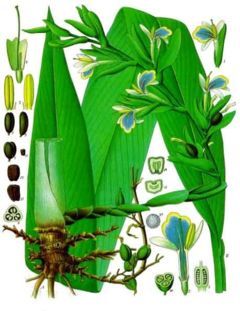Cardamom oil
When used in skin care recipes this can be a spice of life. Its main properties for skin are antioxidant, antiseptic, cleansing. Cardamom oil is one of the oldest essential oil known. Egyptians used it in perfumes and incense. The warming properties found in the spice also make the essential oil useful in massage oil formulas. It is better to use on oil-rich skin and not on sensitive or allergic skin. In homemade skin care recipes it can act as a preservative.
An essential oil can be obtained through steam distillation. The oil has the aroma of freshly dried cardamom pods. The oil is a deep yellow, rich and viscous oil, primarily of a middle note. The lovely aroma is found to be uplifting, invigorating and refreshing, adding a little spice on its own or to blends.
In Traditional Chinese Medicine (TCM), cardamom oil has long been described as a Qi tonic, not only warming and invigorating to the lungs, spleen and nerves, but also having an effect on the spirit or mind, similar to that of basil, removing listlessness and depression often found in chronic Qi deficiency conditions.
In traditional medicine
Cardamom oil is used as warming to the body, relieves pains, it is mood up lifting, improves digestion and improves mental clarity and memory.
Cardamom fruit and seedsIn India, green cardamom (A. subulatum), or "elaichi," is broadly used to treat infections in teeth and gums, to prevent and treat throat troubles, congestion of the lungs and pulmonary tuberculosis, inflammation of eyelids and also digestive disorders. It is also reportedly used as an antidote for both snake and scorpion venom.
Species in the genus Amomum are also used in traditional Indian medicine. Among other species, varieties and cultivars, Amomum villosum is used in traditional Chinese medicine to treat stomach-aches, constipation, dysentery, and other digestion problems. "Tsaoko" cardamom is cultivated in Yunnan, China, both for medicinal purposes and as a spice.

From Wikipedi
Elettaria is a genus of one or two species of cardamoms, native to southeastern Asia from India south to Sri Lanka and east to Malaysia and western Indonesia, where it grows in tropical rainforests.
Some authorities treat the genus as containing only one species Elettaria cardamomum, while others separate Sri Lankan plants out as a separate species Elettaria repens Sonner. Common names include Green Cardamom, True Cardamom, and (E. repens) Ceylon Cardamom; in Hindi it is Elachi or Elaichi.
Cardamom growing wild in Sikkim, IndiaIt is a pungent aromatic herbaceous perennial plant growing to 2–4 m in height. The leaves are alternate in two ranks, linear-lanceolate, 40-60 cm long, with a long pointed tip. The flowers are white to lilac or pale violet, produced in a loose spike 30-60 cm long. The fruit is a three-sided yellow-green pod 1-2 cm long, containing several black seeds.
Essential Oil Main Section
-
Cardamom Oil
-